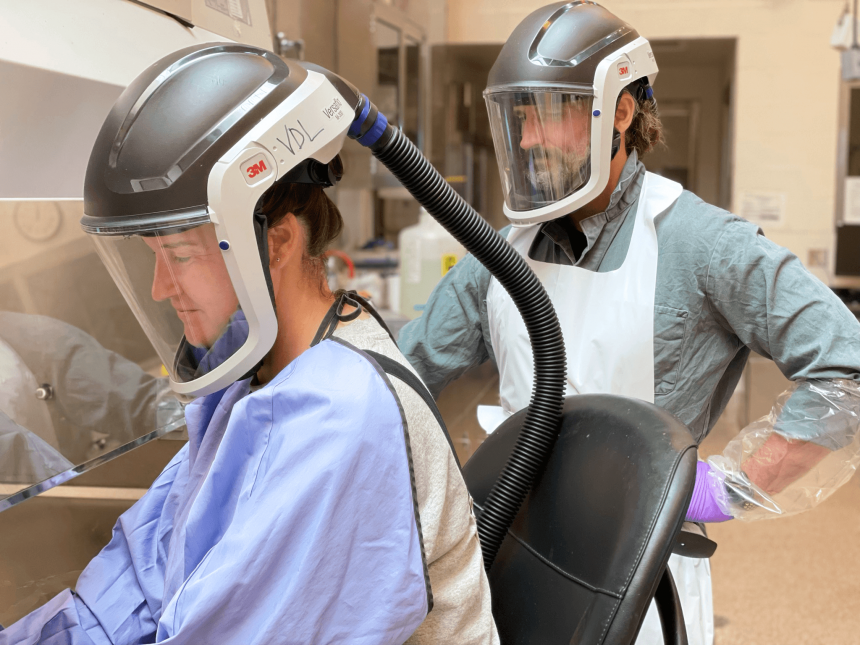By: Dodd Sledge, DVM, PhD, DACVP, Anatomic Pathology Section Chief, Michigan State University Veterinary Diagnostic Laboratory

I make a point to ask each group of veterinary students, veterinary nursing students, and residents training to be pathologists visiting our necropsy floor the same question: Why does someone submit an animal for necropsy?
It’s a fundamental question and one they should understand to best serve their clients once they get into clinics and diagnostic labs. Invariably one of the first answers I get back is to find out why the animal died. It’s not exactly a wrong answer as many animal owners want to know just that. Unfortunately, finding out why an animal died should not be the expectation going into a necropsy as it is rarely something that can be definitively provided. One of the main causes of death we see is euthanasia, and in these cases, the question isn’t why the animal died, but what disease did the animal have when it died? So then, if finding out why an animal died is often not what a necropsy provides, why do we offer necropsies?
To answer this question, you must understand a little about what a necropsy is and what the pathologist performing them does. A necropsy includes careful examination of an animal inside and out along with ancillary testing in other sections of the lab for infectious agents, potential toxins, and nutritional testing as deemed necessary by a pathologist. The examination includes gross evaluation (looking at the animal and its tissues with our eyes) and histologic evaluation (looking at representative portions of collected tissues with a microscope). The pathologist overseeing the necropsy and directing ancillary testing is trained to recognize the changes diseases cause in tissues, which are known as lesions. In simple terms, pathologists are experts in pattern recognition and use the patterns of lesions to diagnose diseases.
So then, what can a necropsy tell you? Quite a lot, but certainly not everything. Necropsies are not a perfect tool. Ultimately, a necropsy can tell you what lesions were present when an animal died, and ideally these can be interpreted by a pathologist along with clinical history and results of ancillary testing to diagnose trauma, infections, toxicoses, nutritional imbalances, or diseases like cancer.
There are, however, many diseases that do not cause lesions visible with the eye or even with the microscope. In particular, diseases that cause dysfunction of an organ, but do not create structural change in tissues are difficult to diagnose. For example, lesions are rare in diseases that cause death extremely quickly such as cardiac arrhythmia or seizures where the main issue is a functional problem in the heart or brain, respectively. Metabolic disorders are another group of diseases that can be difficult to diagnose on necropsy as we are unable to evaluate changes in blood chemistries which reflect the function of body systems post-mortem.
Interpretations of lesions at necropsy are also complicated as decay of the tissues after death or changes associated with handling of the animal such as freezing prior to necropsy can mimic or hide lesions caused by disease. To maximize the potential for a necropsy, animals should be delivered to the laboratory as soon as possible. If the animal cannot be brought in immediately, keep the body cool. Putting a deceased animal in a freezer prior to necropsy is not ideal as freezing and thawing can affect tissues but may be an option if it will be several days before the animal can be brought to the Laboratory.

Given these limitations, necropsies should be considered a tool. They provide parts of the puzzle, but often not a complete picture of what was happening with an animal when it died. A more complete picture is something that really is best put together by a veterinarian that knows the owner and the animal through an established veterinarian-client-patient relationship.
As pathologists that perform an animal’s necropsy, we know only a fraction of that animal’s history. This puts us at a distinct disadvantage. Also, as pathologists, we are not in an ideal position to ask pertinent follow up questions that may help in interpreting findings of a necropsy. We specialize in diagnosis of disease, not treatment or disease prevention. A referring clinical veterinarian is in a much better position to give treatment and management advice for any other animals in the household or pasture.
Revisiting the question why does someone submit an animal for necropsy, there are many, many reasons. For companion animals, one of the biggest reasons is for closure. Owners want to know if they made the right choices and whether their pets suffered. They also want to know whether other animals in the home, they, or their families are at risk.
Production animal or livestock owners certainly care about each and every one of their animals, but for them an individual necropsy is less about the individual animal submitted and more about adjusting herd management to prevent, limit, or treat disease. In essence, the question of choosing to do a necropsy is financial, ultimately based on whether the result is likely to help productivity of the group beyond the cost of the necropsy. The big question isn’t necessarily what disease an individual has, but what do I do about the animals that are still alive?
Veterinarians may suggest necropsies because they want to understand why an animal did not respond to treatment like they anticipated or why there may have been discrepancies between diagnostic tests and how an animal presented. Ultimately, their goal is often to learn so they can approach cases better when an animal presents similarly.
No matter why an animal is submitted for necropsy, our pathologists and staff strive to come to the best possible interpretation and are frustrated when they don’t have all the answers. That said, a necropsy submitted through a veterinarian who can provide a concise and accurate history and who can interpret a necropsy’s findings in the context of a veterinarian-client-patient relationship provides the highest likelihood of answering owners’ questions.
Please Note:
Effective September 1, 2024, the MSU VDL will no longer accept samples directly from pet or horse owners. Necropsies will not be performed until the Laboratory has received a submission form from the referring veterinarian, complete with history and VDL account number. Please see our announcement for more information and our necropsy service page for details on this change in our process.
